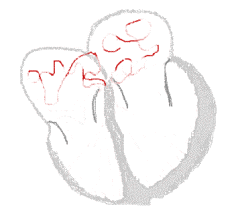Atrial fibrillation
Atrial fibrillation (AF, AFib or A-fib) is an abnormal heart rhythm (arrhythmia) characterised by rapid and irregular beating of the atrial chambers of the heart. This arrhythmia can manifest as brief episodes or can become a persistent condition.
Signs and Symptoms
AF is often asymptomatic but can present with a variety of symptoms, including heart palpitations, fainting, dizziness, lightheadedness, loss of consciousness, shortness of breath, and chest pain. It is associated with a rapid and irregular heart rate, which can lead to decreased cardiac output and symptoms of congestive heart failure such as fatigue and swelling.

Causes and Risk Factors
AF is linked to several cardiovascular diseases and conditions, including high blood pressure, coronary artery disease, and valvular heart diseases like mitral valve stenosis. Other risk factors include lung diseases such as COPD, obesity, sleep apnoea, and excessive alcohol consumption. Genetic predispositions and lifestyle factors like smoking and prolonged endurance exercise can also contribute to the development of AF.

Pathophysiology
Atrial fibrillation is primarily caused by the progressive fibrosis of the atria, which can result from atrial dilation due to various structural heart abnormalities. This fibrosis disrupts the normal electrical conduction system of the heart, leading to disorganised electrical waves and ineffective atrial contractions.

Diagnosis
Diagnosis of AF is typically confirmed using an electrocardiogram (ECG), which shows the absence of P waves and irregular R-R intervals. A transthoracic echocardiogram (TTE) is often performed to assess structural heart disease and atrial size. In cases where AF is suspected but not evident on a standard ECG, ambulatory Holter monitoring or a transesophageal echocardiogram (TEE) may be used.


Treatment
Lifestyle Modifications
Healthy lifestyle changes, such as weight loss, increased physical activity, and reducing alcohol intake, can lower the risk of AF and its burden.
Medications
Medications for AF include those for rate control, rhythm control, and anticoagulation. Rate control medications, such as beta-blockers and calcium channel blockers, aim to keep the heart rate within a normal range. Rhythm control aims to restore and maintain normal sinus rhythm using antiarrhythmic medications or procedures like electrical cardioversion. Anticoagulation, using drugs such as warfarin or direct oral anticoagulants (DOACs), is essential to prevent stroke, especially in high-risk individuals.
Cardioversion and Ablation
Electrical cardioversion can be used to restore normal heart rhythm, especially in emergencies. Catheter ablation is another option, particularly for those who cannot maintain normal rhythm with medication. This procedure isolates the pulmonary veins to prevent abnormal electrical activity.
Surgical Interventions
Surgical options include the Maze procedure, which creates electrical barriers in the atria to restore normal rhythm. Left atrial appendage occlusion is another surgical technique to reduce stroke risk in non-valvular AF.

Prognosis
AF can progress from paroxysmal to permanent forms, and it increases the risk of heart failure, stroke, and dementia. The CHA2DS2\-VASc score can help assess the risk of stroke and guide anticoagulation therapy. Effective management of underlying conditions and lifestyle modifications are very important in improving outcomes for individuals with AF.
Self-assessment MCQs (single best answer)
Which of the following is NOT a common symptom of atrial fibrillation (AF)?
What is the primary cause of atrial fibrillation?
Which test is most commonly used to confirm a diagnosis of atrial fibrillation?
Which lifestyle modification is NOT recommended for lowering the risk of atrial fibrillation?
Which medication is used for anticoagulation in atrial fibrillation to prevent stroke?
What is the purpose of catheter ablation in the treatment of atrial fibrillation?
Which of the following is a non-modifiable risk factor for atrial fibrillation?
What does the CHA2DS2-VASc score assess in patients with atrial fibrillation?
Which surgical procedure creates electrical barriers in the atria to restore normal rhythm in atrial fibrillation patients?
Which of the following is NOT typically a part of the treatment strategy for atrial fibrillation?
Dentaljuce
Dentaljuce provides Enhanced Continuing Professional Development (CPD) with GDC-approved Certificates for dental professionals worldwide.
Founded in 2009 by the award-winning Masters team from the School of Dentistry at the University of Birmingham, Dentaljuce has established itself as the leading platform for online CPD.
With over 100 high-quality online courses available for a single annual membership fee, Dentaljuce offers comprehensive e-learning designed for busy dental professionals.
The courses cover a complete range of topics, from clinical skills to patient communication, and are suitable for dentists, nurses, hygienists, therapists, students, and practice managers.
Dentaljuce features Dr. Aiden, a dentally trained AI-powered personal tutor available 24/7 to assist with queries and provide guidance through complex topics, enhancing the learning experience.
Check out our range of courses, or sign up now!


